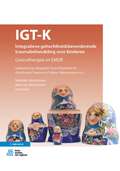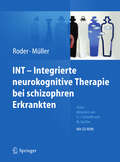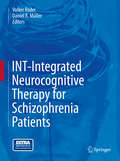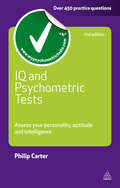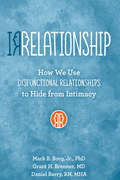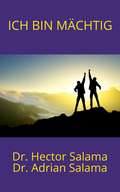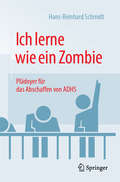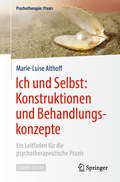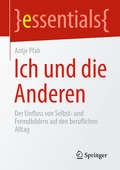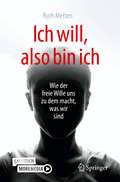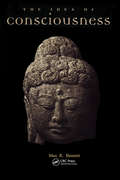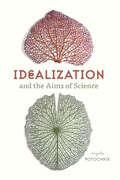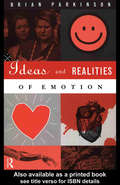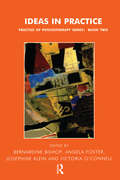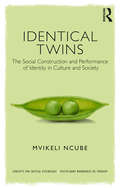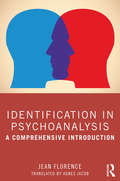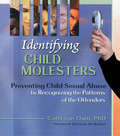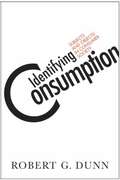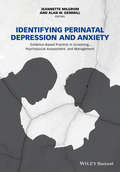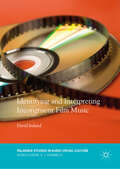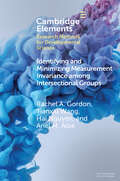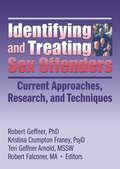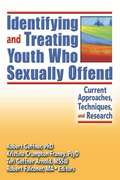- Table View
- List View
IGT-K Integratieve gehechtheidsbevorderende traumabehandeling voor kinderen: Gezinstherapie en EMDR
by Nathalie Schlattmann Mara van der Hoeven Irma HeinDit boek biedt de handleiding voor therapeuten die de IGT-K behandeling geven (www.igtk.nl). Het bevat een algemene inleiding in het behandelmodel, de theoretische achtergrond, en het behandelprotocol voor de beide therapeuten die samenwerken in deze behandeling: de EMDR-practitioner en de gezinstherapeut. Kinderen die nare gebeurtenissen hebben meegemaakt binnen de gehechtheidsrelatie met hun ouders, hebben intense pijn, angst en wantrouwen ervaren. Dit kan bijvoorbeeld door mishandeling, verwaarlozing, medische ingrepen of uithuisplaatsingen vanaf jonge leeftijd. Deze gevoelens uiten zich vaak in ‘lastig’ gedrag zoals agressie of extreme geslotenheid, zelfs nadat de opvoedomgeving is veranderd door adoptie, pleeggezinplaatsing, een andere jeugdbeschermingsmaatregel of het oplossen van de problemen in het gezin. IGT-K is een intensieve behandeling voor kinderen van 6 tot 16 jaar die last hebben van problemen op het gebied van gehechtheid, trauma, gedrag en emotieregulatie, bij wie een eerste keus traumabehandeling niet lukt. De kinderen kunnen te vermijdend zijn of te snel ontregelen. Bij IGT-K werken een EMDR-therapeut en een gezinstherapeut nauw samen, om de traumaverwerking mogelijk te maken door middel van voorbereidende technieken die gehechtheid en zelfregulatie bevorderen. Het gezin en het kind leren begrijpen op welke manier de huidige klachten gerelateerd zijn aan de gebeurtenissen in het verleden, en de relatie tussen het kind en de (pleeg-)ouder verbetert waarna de ouder het kind beter kan ondersteunen in de traumaverwerkingsfase. IGT-K wordt onderzocht en de eerste resultaten zijn veelbelovend. IGT-K is gebaseerd op het boek boek Integrative Team Treatment for Attachment Trauma in Children, geschreven door Debra Wesselmann, Cathy Schweitzer and Stefanie Armstrong (Norton: New York, 2014). De Nederlandse bewerking is verzorgd door Nathalie Schlattmann, klinisch psycholoog, EMDR- en TF-CBT supervisor, Mara van der Hoeven, orthopedagoog en onderzoeker, en Irma Hein, kinderpsychiater, traumatherapeut en senior onderzoeker. Zij zijn alle drie verbonden aan Levvel, specialisten voor jeugd en gezin, te Amsterdam. Zij bewerkten ook het boek Integratief Opvoeden, Strategieën voor de opvoeding van kinderen met gehechtheidstrauma, dat gebruikt wordt in de gezinsbehandeling van IGT-K.
INT - Integrierte neurokognitive Therapie bei schizophren Erkrankten
by Volker Roder Daniel R. Müller Marc Lächler Stefanie J. SchmidtDie Integrierte neurokognitive Therapie (INT) ist ein Gruppentherapieansatz, der erstmals alle Bereiche der MATRICS-Initiative des NIMH (National Institute of Mental Health, USA) in ein umfassendes Therapiekonzept integriert (MATRICS: Measurement and Treatment Research to improve Cognition in Schizophrenia). Diese Initiative definierte 11 neuro- und sozialkognitive Funktionsbereiche, die für schizophren Erkrankte relevant sind und deren Stärkung eines der wichtigsten Therapieziele sein muss. Die INT basiert auf den kognitiven Unterprogrammen des weitverbreiteten und umfassend evaluierten Integrierten psychologischen Therapieprogamms (IPT). Die INT ist ein ressourcen- und recovery-orientierter Ansatz, der auch die Verbesserung von Therapiemotivation und Selbstwahrnehmung zum Ziel hat. Der Fokus liegt konsequent auf der Gruppendynamik und dem Selbst- und Alltagsbezug der Patienten. Übergeordnetes Ziel ist die Erhöhung der Lebensqualität und -funktionalität und damit die Wiedereingliederung der Patienten in die Gesellschaft. Das vorliegende Manual - ... bietet dem Kliniker einen gut verständlichen Einstieg in die Behandlung von Neuro- und sozialen Kognitionen im Rahmen eines umfassenden und gut aufeinander abgestimmten Therapie- und Behandlungsangebots - ... beschreibt detailliert und gut strukturiert den Aufbau der INT in 4 Modulen - ... veranschaulicht mit zahlreichen Fallbeispielen das therapeutische Vorgehen auch in schwierigen Therapiesituationen - ... enthält umfangreiche und teilweise computergestützte Therapiematerialien, die sich patientenorientiert und vielfältig - auch im Einzelsetting - einsetzen lassen - ... thematisiert in kleineren Einheiten mögliche Indikationsstellungen, eine sorgfältige und individuell abgestimmte Therapieplanung ("Fallkonzeption") und Implementierung der INT Die INT wurde von Therapeuten und Patienten sehr gut angenommen und durch eine internationale, randomisierte Multicenterstudie in Deutschland, Österreich und der Schweiz erfolgreich evaluiert. Das Manual eignet sich hervorragend zur Vorbereitung und Durchführung von Therapiesitzungen.
INT-Integrated Neurocognitive Therapy for Schizophrenia Patients
by Volker Roder Daniel R. MüllerThis book contains concrete and step by step information with many practical examples. It is in line with the most actual international empirical findings about schizophrenia and contains the most updated therapy approach being available currently. The techniques and exercises (partly computer-based) are described in detail. Case examples point out specific therapeutic situations and teach the therapist how to cope with complicated group and individual demands. Assessment for patient selection, differential indication and therapy control within a multi-dimensional treatment and rehabilitation system are discussed. INT was evaluated successfully in an international randomised multi-centre study. In the meantime it is implemented in many clinical settings in German speaking countries. Integrated Neurocognitive Therapy (INT) is a cognitive remediation therapy approach. INT is the first treatment manual comprising all MATRICS areas (Measurement and Treatment Research to Improve Cognition in Schizophrenia). The NIMH (National Institute of Mental Health, USA) initiated this MATRICS initiative. MATRICS defines 11 neurocognitive and social cognitive areas of functioning being relevant for patients with schizophrenia. The improvement of these areas in a group therapy is the main goal of INT. INT is based on IPT (Integrated Psychological Therapy, Roder et al 2010). It is a resource and a recovery oriented intervention to enhance also therapy motivation and self-esteem and to reduce negative symptoms. Therapy focuses especially on group processes and the exercises augment transfer and generalisation to daily life. As a meta goal INT intends to amend life quality and the reintegration of the patients in the community. The presented manual offers the clinicians a practically orientated guide for carrying out INT.
IQ and Psychometric Tests: Assess Your Personality Aptitude and Intelligence (Testing Series)
by Philip CarterIQ and psychometric tests are increasingly used in recruitment and selection procedures by those companies who want to ensure they employ workers of the highest calibre.With hundreds of questions on verbal, numerical and spatial ability, memory, creativity and personality, IQ and Psychometric Tests will help you to weigh up your strengths and weaknesses and improve your score. It also includes two full length IQ tests.Vital preparation for anyone facing these tests as part of a recruitment procedure, IQ and Psychometric Tests will also appeal to anyone who enjoys stretching their mind and exercising their brain.
IRRELATIONSHIP: How we use Dysfunctional Relationships to Hide from Intimacy
by Grant H Brenner Daniel Berry Mark B. BorgAn important and transformative guide that addresses the protective, yet dysfunctional dynamic where couples avoid genuine connection with an unsatisfying pattern of false intimacy. Drawing on their extensive clinical experience, the authors look at "song and dance" behavioral routines repeatedly performed by couples in irrelationships and delve into the most difficult emotions and actions to help readers achieve personal breakthroughs.Written for anyone who wants to understand unhealthy patterns and how to change them, Irrelationships will help readers develop interpersonal skills, creating a new opportunity to heal and restore loving relationships.Mark B. Borg, Jr., PhD, is a community psychologist and psychoanalyst, and a supervisor of psychotherapy at the William Alanson White Institute.Grant H. Brenner, MD, is a board-certified psychiatrist in private practice, specializing in treating mood and anxiety disorders and the complex problems that may arise in adulthood from childhood trauma and loss. Daniel Berry, RN, MHA, has practiced as a Registered Nurse in New York City since 1987 and has worked for almost two decades in community-based programs.
Ibn Gabirol's Theology of Desire
by Sarah PessinDrawing on Arabic passages from Ibn Gabirol's original Fons Vitae text, and highlighting philosophical insights from his Hebrew poetry, Sarah Pessin develops a "Theology of Desire" at the heart of Ibn Gabirol's eleventh-century cosmo-ontology. She challenges centuries of received scholarship on his work, including his so-called Doctrine of Divine Will. Pessin rejects voluntarist readings of the Fons Vitae as opposing divine emanation. She also emphasizes Pseudo-Empedoclean notions of "Divine Desire" and "Grounding Element" alongside Ibn Gabirol's use of a particularly Neoplatonic method with apophatic (and what she terms "doubly apophatic") implications. In this way, Pessin reads claims about matter and God as insights about love, desire, and the receptive, dependent, and fragile nature of human being. Pessin reenvisions the entire spirit of Ibn Gabirol's philosophy, moving us from a set of doctrines to a fluid inquiry into the nature of God and human being - and the bond between God and human being in desire.
Ich bin mächtig
by Adrian Salama Hector SalamaEs ist an der Zeit, Ihre Beziehung zum Wohlstand zu verbessern. In diesem Buch werden die besten Techniken und Strategien zur Steigerung Ihres Wohlstands anhand von Methoden erörtert, die sich im Laufe der Zeit bewährt haben. Mit den besten Techniken der Gestalt-Psychotherapie, sowie anhand persönlicher Fälle wurde das gesamte Buch so gestaltet, dass Sie das Maximum Ihrer persönlichen Entwicklung erreichen können. Dieses Buch richtet sich an Menschen, die die ihnen innewohnende Macht ablehnen und nicht wissen, wie sie diese in die Tat umsetzen können. -Sie haben einen Traum und wissen nicht, wie sie ihn verwirklichen können. -Sie sind in finanzielle Krisen geraten und müssen daraus herauskommen. -Sie besitzen eine großartige Idee und benötigen nur die richtige Motivation. -Sie suchen eine größere finanzielle Sicherheit. Wenn Sie sich sicher sind, dass Sie das Ihnen innewohnende Potenzial ausschöpfen möchten, ist dies der richtige Zeitpunkt, um dieses Buch zu lesen. Es ist leicht zu lesen und kann rasch angewendet werden. Worauf warten Sie noch?
Ich lerne wie ein Zombie: Plädoyer für das Abschaffen von ADHS
by Hans-Reinhard SchmidtDer Psychotherapeut Hans Reinhard Schmidt unterzieht das Konstrukt ADHS einer radikalen Kritik. Er kommt zum Ergebnis, dass die Konstruktion dieser Krankheit mehr Unheil als Segen mit sich bringt und abgeschafft bzw. überwunden werden sollte. Insgesamt arbeitet Schmidt als seine Position heraus: Es gibt kein ADHS und kein ADHS-Kind, sondern viele verschiedene Kinder mit vielen verschiedenen Gründen für ihre Unaufmerksamkeit und Unruhe. Das Buch hinterfragt nicht nur das Konstrukt ADHS gründlich, sondern bietet auch Hilfestellung und fachliche Alternativen.
Ich und Selbst: Ein Leitfaden für die psychotherapeutische Praxis (Psychotherapie: Praxis)
by Marie-Luise AlthoffDieses Buch hilft Psychotherapeuten, Psychiatern und Supervisoren, ihre Patienten und Klienten bei ihrer Identitätssuche und Selbstfindung zu unterstützen. Als Ausgangspunkt der Überlegungen werden die Theorien der Ich- und selbstpsychologischen sowie der relationalen psychodynamischen Richtungen dargestellt. Die Selbst- und Identitätsbildung als Suchbewegung von Klienten und Therapeuten steht im Zentrum der Fragestellungen. Die Autorin gibt fundierte und hilfreiche Antworten – in dem Wissen, dass Antworten nie ein für alle Mal gelten und doch zufriedenstellend sein können. Wir transformieren uns fortwährend und können uns letztlich nie auf etwas Eigentliches zurückführen. Fragen aus dem Inhalt: Menschen sagen: „Ich suche mich“, „Ich finde mich“, „Ich erfinde mich neu.“ Wer oder was ist eigentlich dieses Ich, wer oder was ist dieses Mich, und was machen die beiden da, wenn sie sich suchen, finden oder erfinden? Machen die beiden das stets und ständig und beeinflussen sie sich wechselseitig? „Ich kann mich selbst so schwer verstehen?“ Wer oder was ist denn dieses Selbst? Also ist da noch ein Dritter im Bunde, wie immer? In diesem Buch werden Antworten auf diese Fragen gesucht. Die Autorin: Dr. phil. Marie-Luise Althoff ist Analytikerin, Dozentin, Supervisorin und Lehrtherapeutin und diskutiert mit Blick auf Psychotherapie und Supervision die Konzeptualisierung einer Beeinflussung des Ich- und Selbsterlebens.
Ich und die Anderen: Der Einfluss von Selbst- und Fremdbildern auf den beruflichen Alltag (essentials)
by Antje PfabDer Umgang mit anderen Menschen ist geprägt von der eigenen Selbst- und Fremdwahrnehmung. Berufliches Handeln wird von idealen Selbstbildern beeinflusst und kann zu Missverständnissen und Konflikten führen, wenn dieses Bild nicht mit dem Bild Anderer übereinstimmt. Die Autorin erklärt, wie menschliche Wahrnehmung funktioniert, Selbst- und Fremdbilder gebildet werden und welche Rolle die eigene Kultur dabei spielt. Sie gibt Anregungen zu einem bewussteren Umgang mit Selbst- und Fremdbildern.
Ich will, also bin ich: Wie der freie Wille uns zu dem macht, was wir sind
by Ruth MettenDieses Buch appelliert an Sie, Ihren freien Willen zu gebrauchen. Denn allen wissenschaftlichen Unkenrufen zum Trotz: wir haben – wie gezeigt wird – tatsächlich einen freien Willen; wir haben einen Zugriff auf unsere Freiheit. Das ist sogar von allerhöchster Bedeutung: denn unser Selbst scheint erst durch Willensakte zustande zu kommen. Verhält es sich aber so, dann täten wir gut daran, unseren Willen zu bilden, wie es die alten Meditationsschulen empfehlen. Und wodurch gelingt das? Indem wir uns in Achtsamkeit und Selbsthypnose üben, wozu der letzte Teil des Buches anleiten will. Mit einem Geleitwort von Dr. Burkhard Peter. Aus dem Inhalt: Der freie Wille – eine Illusion? – Leben gedeiht in Freiheit – Rückschläge – Mit vielen Beispielen, Übungen und Aha-Momenten. Mit Hörübungen zum Download. Über die Autorin: Dr. med. Ruth Metten ist als Fachärztin für Psychiatrie und Psychotherapie in Kempen niedergelassen, beschäftigt sich mit Sterbebegleitung, Achtsamkeit und Selbsthypnose und hält zum Thema dieses Buches Vorträge und Seminare.
Iconic Power
by Jeffrey C. Alexander Dominik Bartma´nski Bernhard GiesenAcollection of original articles that explore social aspects of the phenomenon of icon. Having experienced the benefits and realized the limitations of so called 'linguistic turn', sociology has recently acknowledged a need to further expand its horizons. "
Idea of Consciousness: Synapses and the Mind
by Max R. BennettThe Idea of Consciousness examines the problem of how the working of synaptic connections might give rise to consciousness, and describes the current neuroscientific concepts and techniques used to identify and explore those parts of the brain that may be involved. This book will serve as an invaluable and stimulating introduction to the subject. Beautifully illustrated, it is a must for anyone who is curious about consciousness.
Idealization and the Aims of Science
by Angela PotochnikScience is the study of our world, as it is in its messy reality. Nonetheless, science requires idealization to function—if we are to attempt to understand the world, we have to find ways to reduce its complexity. Idealization and the Aims of Science shows just how crucial idealization is to science and why it matters. Beginning with the acknowledgment of our status as limited human agents trying to make sense of an exceedingly complex world, Angela Potochnik moves on to explain how science aims to depict and make use of causal patterns—a project that makes essential use of idealization. She offers case studies from a number of branches of science to demonstrate the ubiquity of idealization, shows how causal patterns are used to develop scientific explanations, and describes how the necessarily imperfect connection between science and truth leads to researchers’ values influencing their findings. The resulting book is a tour de force, a synthesis of the study of idealization that also offers countless new insights and avenues for future exploration.
Ideas and Realities of Emotion (International Library Of Psychology Ser.)
by Brian ParkinsonA clear and concise overview of state-of-the-art reasearch into emotion focusing on cognitive appraisal, bodily changes, action tendencies and expressive displays.
Ideas in Practice (The\lcp Practice In Psychotherapy Ser. #Vol. 2)
by Bernardine Bishop Angela Foster Josephine Klein Victoria O’ConnellComprising the second volume in the series The Practice of Psychotherapy, this volume brings together six contributors, all members of the London Centre for Psychotherapy, presenting psychoanalytic ideas lucidly illustrated by clinical observatioins taken from the consulting room. Focusing upon such issues as sibling attachment and the impact of maternal absence, this collection of essays offers uniquely personal insights and new idrom psychotherapeutic encounters. The author believes that in each of these papers there is the spark of an original idea...grounded indeed in psychoanalytic theory, but influenced by individual experience and observation in the consulting room.
Identical Twins: The Social Construction and Performance of Identity in Culture and Society (Concepts for Critical Psychology)
by Mvikeli NcubeIn Identical Twins: The Social Construction and Performance of Identity in Culture and Society, Ncube conceptualises twin identity as a multi-layered dynamic that changes through performance, and explores twin identity through a social constructionist approach. Until now, mainstream twin studies have mostly sought to explain social phenomena about twins from ‘inside’ the person, providing their explanations in terms of internal entities such as personality structures with an obvious underlying essentialist assumption. By examining the theories of Michel Foucault and Judith Butler, Ncube shows that the ‘identity’ of twins is managed in both an academic and cultural context, and in relation to specific audiences. Relocating the explanations that we gather in social research, including in qualitative research in psychology, the book focuses its enquiry on the social practices and interactions that people engage in with each other, not delving ‘inside’ the person. Using real-world twin accounts, the book maps out the social construction of twin identity, and allows for the twins’ own voices to be examined in relation to twin experiences. Also addressing aspects of being misunderstood, as well as the idea of misunderstanding oneself, this is fascinating reading for students and researchers in critical and cultural psychology, and anyone interested in twin studies.
Identification in Psychoanalysis: A Comprehensive Introduction
by Jean FlorenceThis fascinating book offers an in-depth exploration of the gradual development of the concept of identification as it has evolved in the Freudian tradition of psychoanalysis. Featuring a detailed review of the key Freudian texts, referencing them in their original German, this volume demonstrates how psychoanalysis sheds light on the richness and complexity of the identification process in human psychology, at both the individual and collective levels. The author closely follows the various reformulations of the theory – undertaken by Freud in the course of three different periods – and contextualises them within her clinical experience with various pathologies and her observations of the development of individuals, revealing throughout the great extent to which this fundamental process is unconscious. Providing a critical examination of a fundamental Freudian concept, this volume is not only a teaching manual serving specifically to train psychoanalysts and psychotherapists but is also an important read for anyone interested in human sciences, philosophy and the history of psychoanalysis.
Identifying Child Molesters: Preventing Child Sexual Abuse by Recognizing the Patterns of the Offenders
by Carla Van DamStop abuse before it starts!Identifying Child Molesters: Preventing Child Sexual Abuse by Recognizing the Patterns of the Offenders will teach you to better protect children from potential child sexual molesters long before any abuse can actually occur. Here you'll learn to recognize and understand the seemingly invisible steps that typically precede child sexual abuse. These stories of molesters, their families, and their victims, will enable you to more accurately see through a potential molester's charming demeanor and better protect the children in your life. Understanding the behavior that molesters often exhibit when trying to obtain access to children is essential to protecting children from their advances. By becoming familiar with this terrain you will find the courage and strength to decide what must be done, and the skills to follow through with the necessary actions. Such responses will appropriately curtail an offender's access to children and subsequent opportunities to molest.Identifying Child Molesters will teach you: how to recognize those who might molest how molesters typically 'charm’adults how societal attitudes help to foster child sexual abuse what to do when encountering a potential molester what physical and emotional damage molestation can cause to victims how to graciously avoid potentially dangerous situationsIdentifying Child Molesters: Preventing Child Sexual Abuse by Recognizing the Patterns of the Offenders clearly spells out the techniques that child sexual molesters so successfully use to charm adults into giving them access to children. When these strategies are seen and understood, adults can take much more direct responsibility for preventing child sexual abuse than was previously possible.Anyone who lives or works with children needs to own this book. The information you'll encounter in Identifying Child Molesters might startle you, but it might also help you save the life of a child!
Identifying Consumption: Subjects and Objects in Consumer Society
by Robert G. DunnIdentifying Consumption illustrates how an individual's buying habits are shaped by the dynamics of the consumer marketplace--and thus how consumption and identity inform each other. Robert Dunn brings together the various theories of spending and develops a mode of analysis concentrating on the individual subjectivity of consumption. By doing so, he addresses how we spend and its relationship with status and lifestyle. Dunn provides a comprehensive guide to the study of modern consumer behavior before summarizing and critiquing the major theories of consumption. At this juncture, he proposes a method of analysis that focuses on the significance of status and lifestyle in social relations that can help explain how the consumer marketplace is shaped. He concludes by raising issues about different ways of consuming and the relationship between consumption and identity.
Identifying Perinatal Depression and Anxiety: Evidence-based Practice in Screening, Psychosocial Assessment and Management
by Jeannette Milgrom Alan W. GemmillIdentifying Perinatal Depression and Anxiety brings together the very latest research and clinical practice on this topic from around the world in one valuable resource. Examines current screening and management models, particularly those in Australia, England and Wales, Scotland, and the United States Discusses the evidence, accuracy, and limitations of screening methods in the context of challenges, policy issues, and questions that require further research Up to date practical guidance of how to screen, assess, diagnose and manage is provided. Considers the importance of screening processes that involve infants and fathers, additional training for health professionals, pathways to care following screening, and the economics of screening Offers forward-thinking synthesis and analysis of the current state of the field by leading international experts, with the goal of sketching out areas in need of future research
Identifying and Interpreting Incongruent Film Music (Palgrave Studies in Audio-Visual Culture)
by David IrelandThis book explores the concept of incongruent film music, challenging the idea that this label only describes music that is inappropriate or misfitting for a film’s images and narrative. Defining incongruence as a lack of shared properties in the audiovisual relationship, this study examines various types of incongruence between a film and its music and considers the active role that it can play in the construction of a film’s meaning and influencing audience response. Synthesising findings from research in the psychology of music in multimedia, as well as from ideas sourced in semiotics, film music, and poststructuralist theory, this interdisciplinary book provides a holistic perspective that reflects the complexity of moments of film-music incongruence. With case studies including well-known films such as Gladiator and The Shawshank Redemption, this book combines scene analysis and empirical audience reception tests to emphasise the subjectivity, context-dependency, and multi-dimensionality inherent in identifying and interpreting incongruent film music.
Identifying and Minimizing Measurement Invariance among Intersectional Groups: The Alignment Method Applied to Multi-category Items (Elements in Research Methods for Developmental Science)
by Rachel A. Gordon Tianxiu Wang Hai Nguyen Ariel M. AloeThis Element demonstrates how and why the alignment method can advance measurement fairness in developmental science. It explains its application to multi-category items in an accessible way, offering sample code and demonstrating an R package that facilitates interpretation of such items' multiple thresholds. It features the implications for group mean differences when differences in the thresholds between categories are ignored because items are treated as continuous, using an example of intersectional groups defined by assigned sex and race/ethnicity. It demonstrates the interpretation of item-level partial non-invariance results and their implications for group-level differences and encourages substantive theorizing regarding measurement fairness.
Identifying and Treating Sex Offenders: Current Approaches, Research, and Techniques
by Robert Geffner Kristina Crumpton Franey Teri Geffner Arnold Robert FalconerGain a better understanding of the behaviors of sex offenders to create effective interventions! Identifying and Treating Sex Offenders: Current Approaches, Research, and Techniques brings you up-to-date on the latest significant issues and state-of-the-art tools involved in the evaluation and treatment of adult sex offenders. This book pr
Identifying and Treating Youth Who Sexually Offend: Current Approaches, Techniques, and Research
by Kristina Crumpton FraneyWhat factors contribute to the making of a youthful sexual offender?This book is designed to assist professionals working with youth who sexually offend. A distinguished panel of experts discusses the latest research and provides theory, techniques, and practical guidelines for the assessment and treatment of this challenging population. Identifying and Treating Youth Who Sexually Offend: Current Approaches, Techniques, and Research lays an essential foundation with a theoretical overview that frames the subject in a clear, easy-to-follow style. This section includes: a comprehensive overview of the controversies, definitions, and salient characteristics of youth who sexually offend that that provides an understanding of the factors believed to be related to sex offending among youth as well as an up-to-date review of current theory an examination of an etiological model that is frequently applied to adult sex offenders-is it applicable for use with youthful offenders?The second section of Identifying and Treating Youth Who Sexually Offend tackles the challenges professionals face when conducting assessments of sexually abusive youth. This section is designed to help the clinicians of today and tomorrow become better equipped to handle the daunting task of assessment-from choosing assessment tools to decreasing denial with specific interviewing techniques. Readers will learn: how to distinguish subtypes among this population-with a research review and comparative descriptions of clinical and empirical typologies as well as discussion of the Trauma Outcome Process model and practical examples for clinicians how to predict the rate of re-offense among youth who sexually offend, with a review of five risk assessment methods and four scales plus directions for using them-includes the Juvenile Sex Offender Assessment Protocol (JSOAP), the Protective Factors Scale (PFS), and the Estimate of Risk of Adolescent Sex Offender Recidivism (ERASOR) the "nuts and bolts" of the interviewing and clinical assessment phase of treatment-a look at effective interviewing strategies, the process of change, and the stages of change model the importance of family therapy in the treatment of these youth-ways to include parents in relapse prevention planning and ways to handle treatment providers&’ misconceptions and concerns about including family therapy in this type of treatment cognitive-behavioral treatment models for use in outpatient settings-with treatment strategies directed toward various individual or family clinical targets, including psychological dysfunctions, sexual deviance, adolescent development and adaptive skills, and parent/family relationships an integrated (holistic) experiential approach to treatment, complete with sample exercises and a discussion of the pros and cons of many current treatment modalities a multi-family group therapy (MFGT) approach-with a look at this powerful intervention mode&’s advantages, including economic benefits, family-to-family support and mentoring, community-based resourcefulness, and accelerated catalyzing of emotions, and directions for how to establish a MFGT format for treatment current practices in residential treatment for adolescent sex offenders-policies, testing and assessment procedures, therapeutic approaches used, number of males and females in treatment, etc.The final section of Identifying and Treating Youth Who Sexually Offend explores what happens to youth who sexually offend after they leave treatment. This includes: a survey of the literature on recidivism an evaluation of the effectiveness of treatment of 644 juvenile sex offenders through the meta-analysis of 10 studies-with encouraging results! a look at the life experiences of a samp
